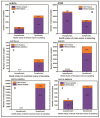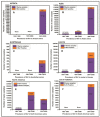A Systematic Review Analyzing the Prevalence and Circulation of Influenza Viruses in Swine Population Worldwide
- PMID: 32397138
- PMCID: PMC7281378
- DOI: 10.3390/pathogens9050355
A Systematic Review Analyzing the Prevalence and Circulation of Influenza Viruses in Swine Population Worldwide
Abstract
The global anxiety and a significant threat to public health due to the current COVID-19 pandemic reiterate the need for active surveillance for the zoonotic virus diseases of pandemic potential. Influenza virus due to its wide host range and zoonotic potential poses such a significant threat to public health. Swine serve as a "mixing vessel" for influenza virus reassortment and evolution which as a result may facilitate the emergence of new strains or subtypes of zoonotic potential. In this context, the currently available scientific data hold a high significance to unravel influenza virus epidemiology and evolution. With this objective, the current systematic review summarizes the original research articles and case reports of all the four types of influenza viruses reported in swine populations worldwide. A total of 281 articles were found eligible through screening of PubMed and Google Scholar databases and hence were included in this systematic review. The highest number of research articles (n = 107) were reported from Asia, followed by Americas (n = 97), Europe (n = 55), Africa (n = 18), and Australia (n = 4). The H1N1, H1N2, H3N2, and A(H1N1)pdm09 viruses were the most common influenza A virus subtypes reported in swine in most countries across the globe, however, few strains of influenza B, C, and D viruses were also reported in certain countries. Multiple reports of the avian influenza virus strains documented in the last two decades in swine in China, the United States, Canada, South Korea, Nigeria, and Egypt provided the evidence of interspecies transmission of influenza viruses from birds to swine. Inter-species transmission of equine influenza virus H3N8 from horse to swine in China expanded the genetic diversity of swine influenza viruses. Additionally, numerous reports of the double and triple-reassortant strains which emerged due to reassortments among avian, human, and swine strains within swine further increased the genetic diversity of swine influenza viruses. These findings are alarming hence active surveillance should be in place to prevent future influenza pandemics.
Keywords: Swine influenza virus; avian-origin influenza virus; influenza A virus; influenza B virus; influenza C virus; influenza D virus; influenza pandemic.
Conflict of interest statement
The authors declare that there is no conflict of interest.
Figures








References
Publication types
LinkOut - more resources
Full Text Sources

